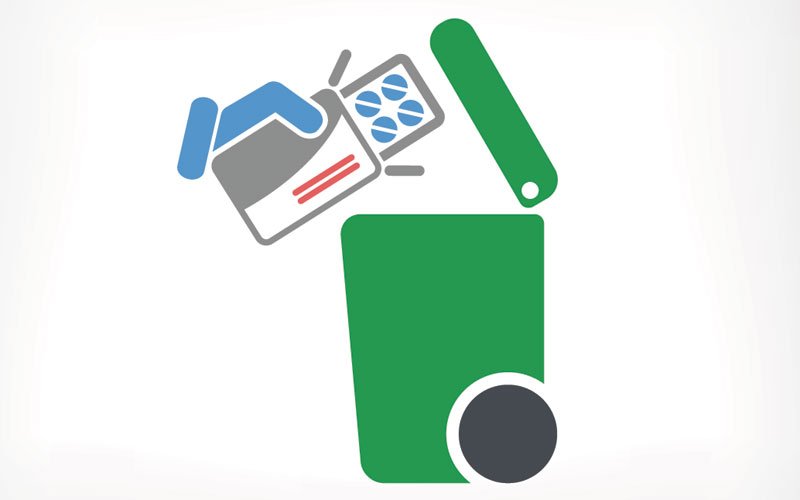The management and disposal of the waste produced in a pharmaceutical manufacturing firm has always been a matter of concern. The waste includes but not limited to in-process wastes, expired products, returned material, manufacturing spillages etc. There has been a lot of hue and cry regarding effective management and disposal of pharma waste as it can act as a possible pollutant. Indiscriminate disposal of drugs may cause pollution of water and soil. The management and disposal of pharmaceutical product has become a concern of prime importance across the globe.
All the drugs available with retailers, chemists, doctors, hospitals, NGOs, wholesalers etc. which have expired or are near expiry shall be returned to the manufacturer as they are better equipped to manage the disposal of such products. All drug products, which are subject for disposal shall be disposed of in accordance with the applicable laws. Manufacturers should also assess the waste and segregate it on the basis of nature of the waste. Hazardous waste shall be handled and disposed of by the professional agencies licensed to dispose such type of wastes.
As per NFI, the waste management shall be initiated with the segregation of the waste:
- Type of dosage form: Tablets, Capsules, Powders, Injectables, Creams, Ointments, Liquids, Ampoules, Vials, Intravenous Infusions etc.
- Chemical nature of drugs: Antineoplastics/Anticancer, β-Lactams, Hormones, Steroids, Anti-infective, Narcotics, Antiseptics and Psychotropic substances etc.
- Packaging material
The methods of disposal of various pharmaceutical dosage forms and that of specific category medicines are as described below:
A. Dosage forms:
- Tablets/ Capsules: Up to 50 tablets or capsules soak in about 100 ml of water and collect the same in a polyethylene bag containing used Tea/Coffee grind. Seal the bag and put in trash. Big quantity – Pulverize using heavy duty crusher. Collect in a poly bag and seal. Dispose it in high temperature incinerator (Temp. 850 ⁰C to 1200 ⁰C)/ approved site for solid waste disposal by the Pollution Control Board of the State.
- Injectables (Ampoules/ Vials): Up to 50 Ampoules/Vials (up to 10 ml) – break ampoules/ open vials and collect liquid in a polyethylene bag containing used Tea/Coffee grind. Seal the bag and put in trash. For bigger quantity, use heavy duty crusher to separate liquid and dilute it with water and transfer it to Effluent Treatment Plant (ETP) of the manufacturing unit. Broken glass/vials (after removal of label), rubber stoppers and seals should be disposed off as scrap. Powder Injectables (in Vials/Ampoules) to be disposed off in an incinerator as indicated above.
- Oral liquids and Intravenous fluids: Dilute the liquid with water and drain it. For bigger quantity, dilute collected liquid with water and transfer it to ETP of the manufacturing unit. Liquids with high solid contents to be disposed off in an incinerator as indicated above.
- Semi solids: Small quantity, mix it with used Tea/Coffee grind in a polyethylene bag. Seal the bag and put in a trash. Deshape the containers/remove the label and discard the containers. Semisolids in bigger quantity to be disposed off in an incinerator mentioned earlier. Containers – Tubes to be de-shaped and remove the label from glass/plastic container before disposal as a scrap.
B. Specific categories based on the chemical nature:
- Anti-infectives-β-lactams: Small quantity of all β-lactam antibiotics to be destroyed by soaking in 1N Sodium Hydroxide for 30 mins or 1% Hydroxylamine in Water for 10 mins and trash. Bigger quantity to be disposed off in an incinerator (Temp. 850⁰C to 1200⁰C) indicated above.
- Anti-infectives – others: Tetracyclines – Small quantity to be soaked in 10% of Calcium Hydroxide/any other Calcium salt in Water for 30 mins and trash. Macrolides – (Erythromycin, Clarithromycin etc.) – Small quantity, soak in 1N Hydrochloric Acid and trash. Amino glycosides (Gentamycin, Amikacin etc.) – Small quantity dilute with large volume of water and drain it. Bigger quantity of all the above anti-infective should be disposed of in an incinerator as mentioned above.
- Steroids: Small quantity – Soak in 1N Sodium Hydroxide for 30 mins and trash. Bigger quantity – all dosage forms (taken out from the primary packing materials) to be incinerated at the temperature range indicated above.
- Hormones: Small quantity – Aqueous solution to be exposed to UV for 20 minutes and trash. Estrogens – small quantity in aqueous solution should be exposed to ultrasound at 0.6 and 2 kw in a sonicator for 60 mins. and trash. Bigger quantity – all solid dosage forms (taken out from primary packaging materials) to be incinerated as indicated above.
- Disinfectants: Small quantity – use it. Bigger quantity – Not more than 50L. Dilute with enough quantity of water to ensure dilution with loss of activity and drain it in ETP.
- Controlled substances: Controlled substance drug products requires very tight control over their inventory and destruction. Small quantity – Flush down the toilet to avoid misuse. Bigger quantity – All dosage forms (take out from primary packaging material) to be incinerated as mentioned above. The destruction of controlled substance products requires specific documentation for the Drug Enforcement Agency in addition of documentation that is required to be maintained for GMP purposes. The disposal of controlled substances often requires witnessing the actual disposal to ensure that the product does not inadvertently re-enter the supply chain.
Disposal by incineration is preferred over chemical inactivation for all dosage forms/APIs
C. Packaging Material: Tertiary (Printed/Labelled Corrugated Boxes) and Secondary (Printed Cartons/Paper box) packaging materials are removed and destroyed with the help of heavy duty paper shredder.
Pollution Control Board or Licensed environmental control agencies shall be hired for disposal of small quantity of expired products in Clinics, Hospitals, Health Care Centers and Dispensaries, Pharmacist etc.
This should be noted that all the destruction procedure shall be well documented as a part of GMP and for submission to the regulatory authorities.
Reference: National Formulary of India.

.png
)
